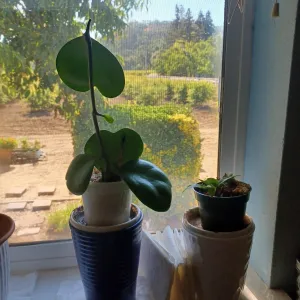Blog by Jenni Dodini
For those of you who have read my blogs before, you know that the first thing that I MUST do when telling the story of a new plant is to blame Toni. It seems that whenever we have an outing to practically anywhere, I come home with a plant that I know absolutely nothing about. She is getting credit for causing this blog.
Recently, we were in a great nursery and I spied this heart-shaped plant. Well, it was one leaf and what looked like a stem behind it. The label said "Hoya". I immediately wanted to say that it is a succulent, so I did. Then I pulled out my phone. My phone said that it is an orchid. OK. Into the cart it went with my other plants. The plan was to give it to my daughter-in-law, so I got a cute little pot for it. Well...I took it home and immediately tried to kill it with water. (Please quit thinking that I should have read about caring for it when I had the site open on my phone.) It is bad form to give someone a dying plant unless that person is tasked with saving it, so onto the kitchen window ledge it went. Fast forward to this year, I looked at it one morning, and noticed there's a stem! So I sent Toni a picture to prove that it was growing! I was so happy with myself and a plant that was going to survive my benign neglect!
Image

Now, I have finally gotten around to doing what I always recommend to everyone — research.
The Hoya (Hoya kerrii) is a genus of around 300 species of tropical plants in the Apocynaceae family. It is native to Asia and can live up to 30 years! Really? That would be a miracle considering my luck with orchids. They are often confused with succulents because of their thick fleshy leaves, which, like succulents, also retain water. That being said, they are very water sensitive and need to be allowed to dry out completely between waterings. They require regular, moderate watering and fast-draining soil, such as orchid bark mix. They also prefer to be root-bound. They are very slow to mature and may take years to flower. The pictures that I saw showed pentagonal-shaped flowers with a red center and pale pink flowers. The information said that they have a sweet fragrance. As far as the care is concerned, they like bright, indirect light (lucked out there) with a temperature around 60 to 75°F and humid air. The site said they like to be in the bathroom during the winter, and they appreciate misting. However, this one is going to continue to live in my kitchen, where it stands a decent chance of being fertilized monthly. Now here's the catch: the size depends on the species. Some are climbers and some trail, so it says "Support if climbing and hang if trailing." It appears that this is a climber, so at some point, I will have to figure out how to support it. Some also like to vine. If mine is a vining one, that falls onto the wait-and-see list of things to think about. Since they prefer being root-bound, I would hesitate to repot in order to support the plant until it was screaming at me and waving roots above the soil surface. And this is because I have killed orchids by repotting in the past. Finally, the last thing to pay attention to, PESTS. They are susceptible to spider mites and mealybugs. The underside of the leaf is where one would check, but these leaves are basically upright, so I would just need to turn the plant and look for webs and or tiny white clusters and any discoloration on the leaves, as well as reduced growth. If this should occur, I would need to isolate the plant and rinse it in warm water, then apply Neem oil or insecticidal soap after pruning off the affected part of the plant. It is also recommended to change out the pot and soil and ensure good airflow around the plant.
Now, you have my story. (And yes, I'm sticking to it.) I have since seen these offered for sale in very small pots, like 2 and 4 inches. I almost bought another on a recent outing, but checked myself when I couldn't figure out where it would fit in my basket. Good thing too, as that was just before this
plant decided to surprise me.
